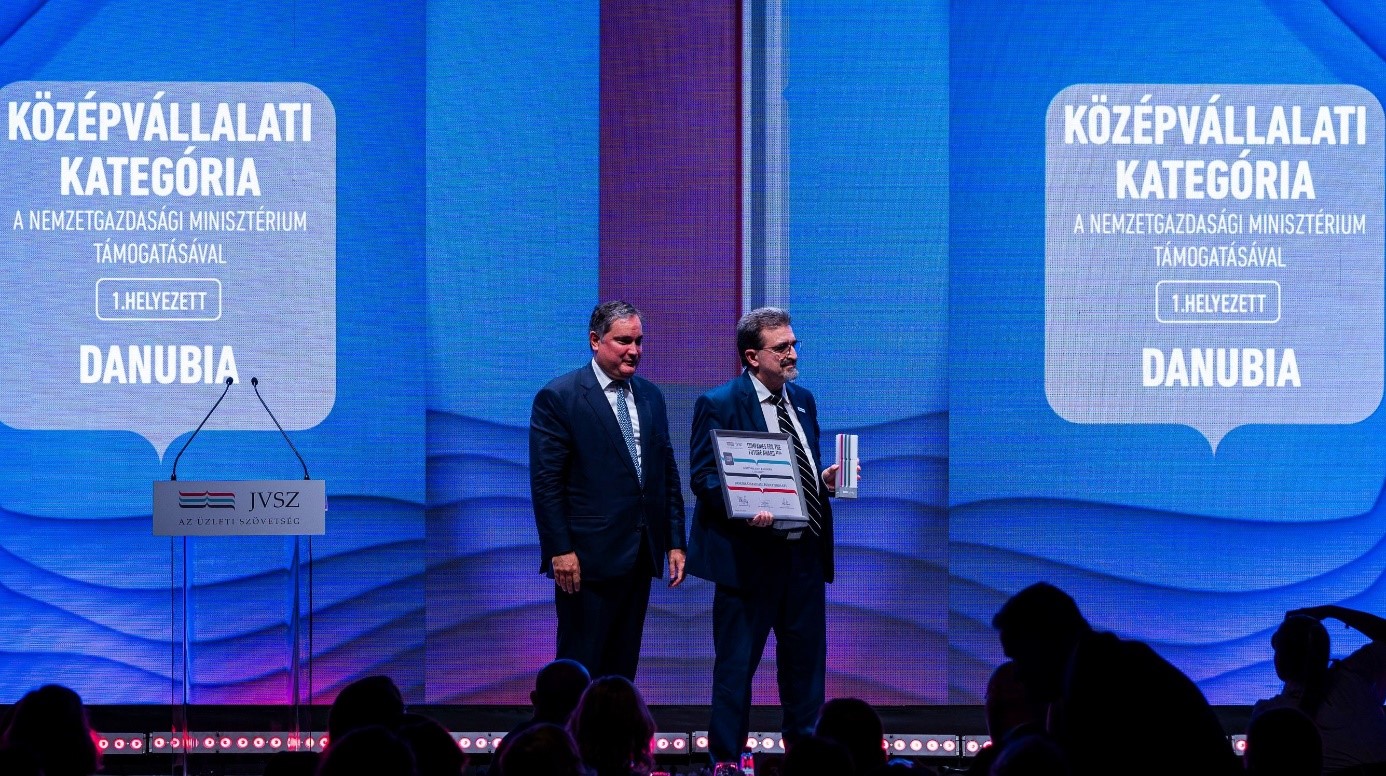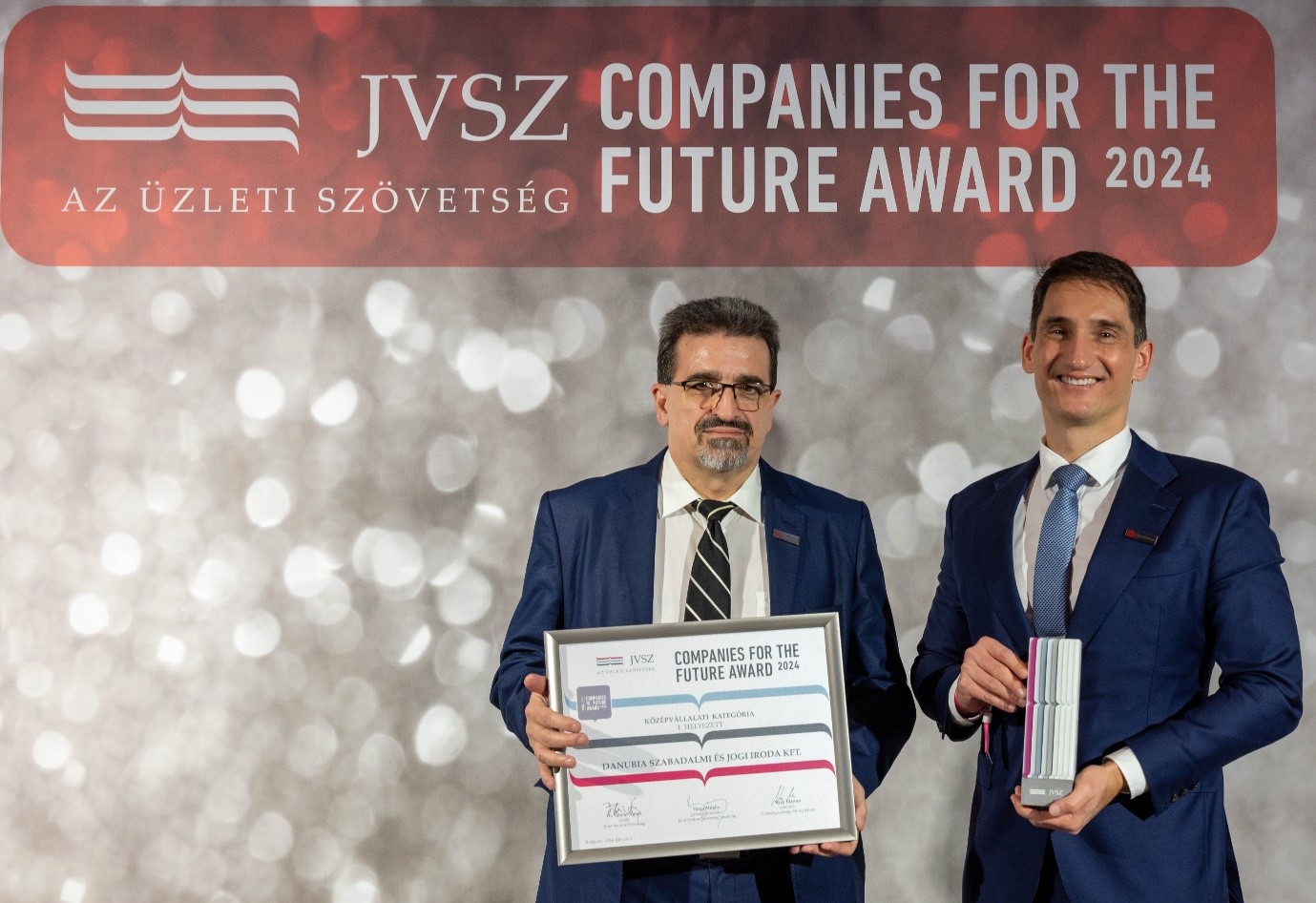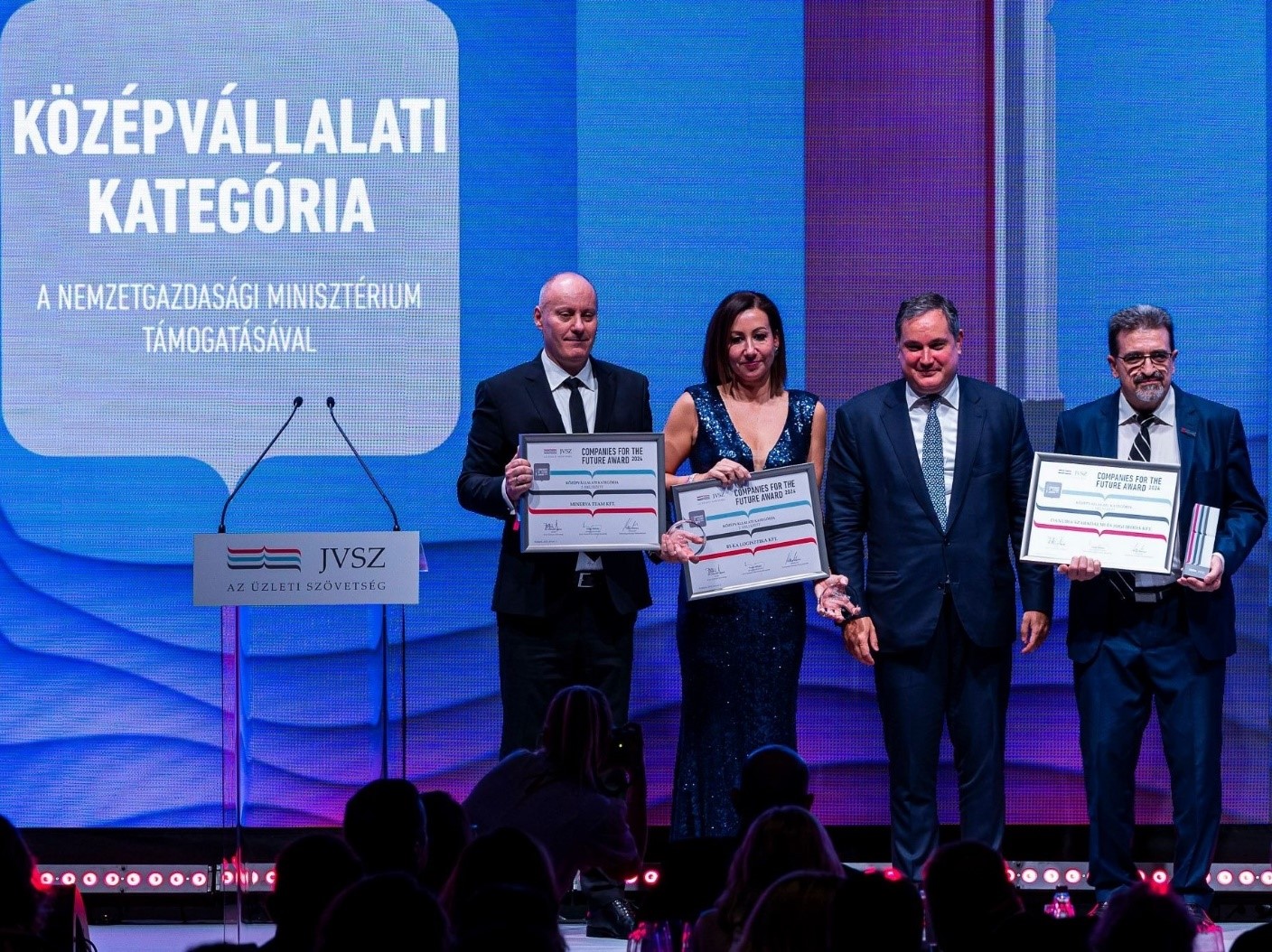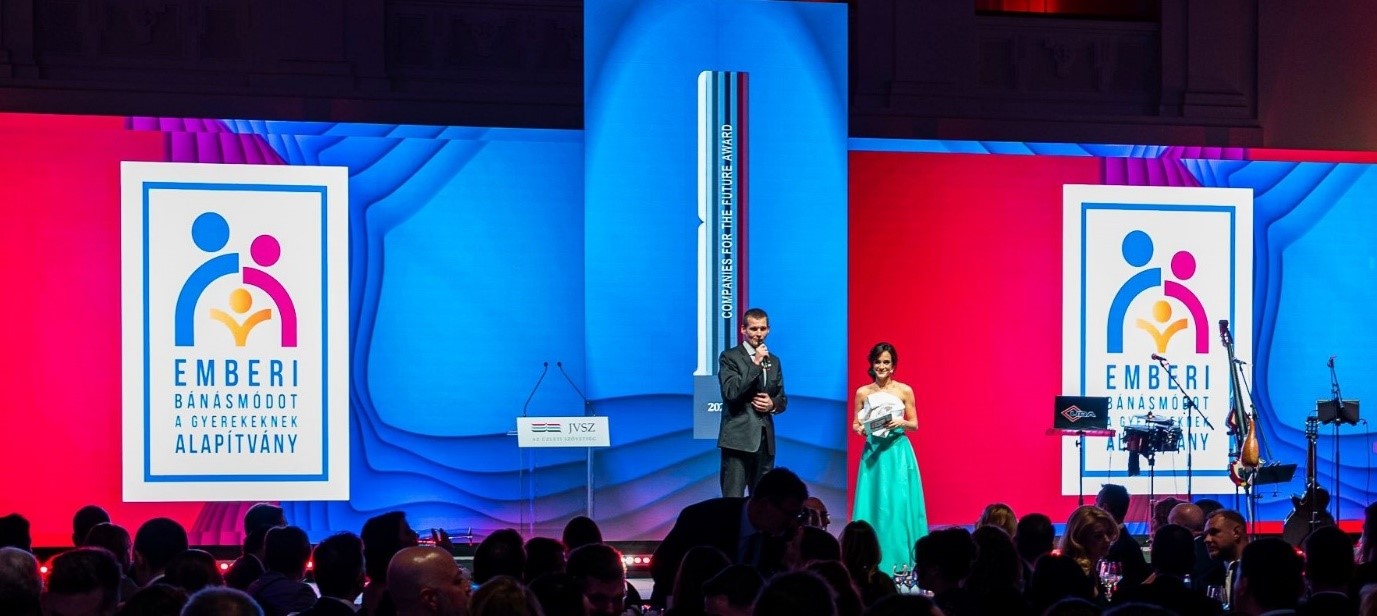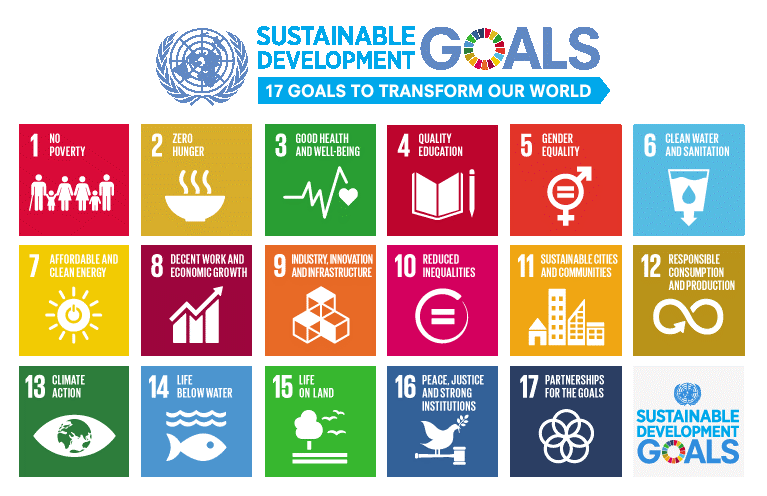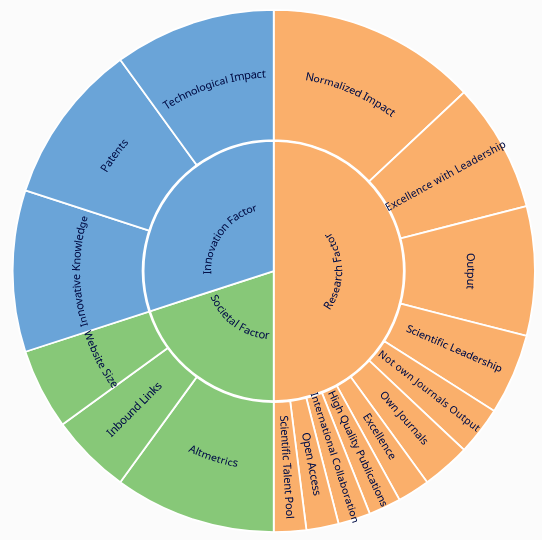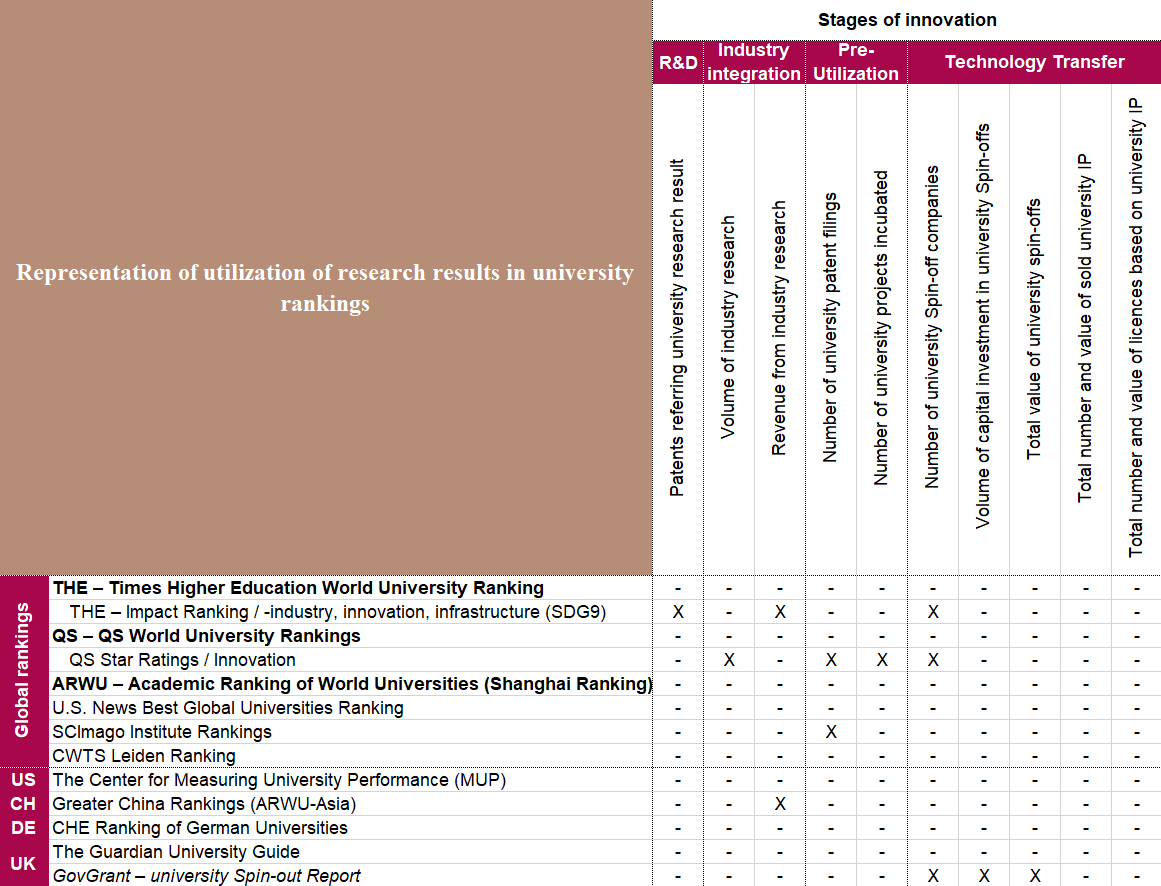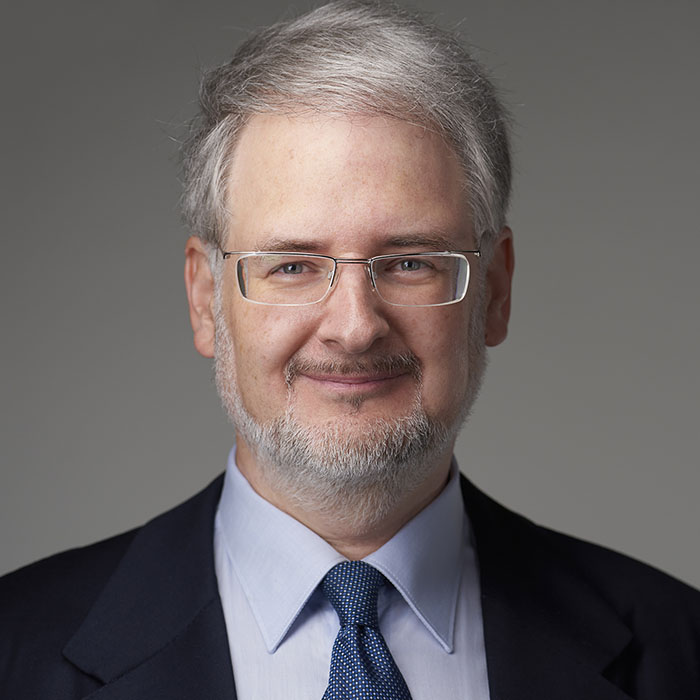Add your feed to SetSticker.com! Promote your sites and attract more customers. It costs only 100 EUROS per YEAR.
Pleasant surprises on every page! Discover new articles, displayed randomly throughout the site. Interesting content, always a click away
Danubia Wins First Place of the Companies For The Future Award 2024 16 Feb 2024, 2:58 pm
Danubia Wins First Place of the Companies For The Future Award 2024
It is with great pleasure that we announce that Danubia has been awarded the Companies For The Future Award 2024 as the first-place winner in the Mid-sized Business Category. This award is a special recognition of the expert work, innovation, and customer-centricity that our firm has demonstrated over the past years.
The award ceremony was organized by the Joint Venture Association (JVSZ), which looks back on nearly 40 years of history and has presented the “Companies for the Future Award” for the third time. The event, held at the prestigious Riding Hall of Buda Castle, was attended by nearly 300 company leaders, and the awards were given to companies that have operated responsibly and consciously with the future of the economy in mind, now across 6 categories.
Márton Nagy, the Minister of National Economy, supported by the Ministry of National Economy and acting as the main patron of the event, presented the awards, highlighting the positive impact of exemplary companies on our future. The order of the awardees was decided by a high-prestige professional jury based on a thoroughly compiled criteria system.
The event celebrated not only business success but also placed a strong emphasis on social responsibility. A charity raffle was a returning and indispensable part of the gala, with all proceeds, totalling 2.5 million HUF, donated through the Human Treatment for Children Foundation to the Cseppkő Children’s Home Center, thereby supporting the lives of children in particularly disadvantaged situations.
We would like to express our gratitude not only to all our colleagues, whose dedicated work and expertise were indispensable for achieving our success, but also to our clients, who have supported us with their trust and loyalty on this journey. Having operated as a market leader in the field of intellectual property protection services in Hungary for 75 years, this award symbolizes our joint success.
You can view the introductory film prepared by the Danubia Corporate Group for the event here. Detailed reports about the event and other awardees can be read here.
The post Danubia Wins First Place of the Companies For The Future Award 2024 appeared first on Danubia.
(video/mp4)
TRADEMARK PROTECTION OF A COLOUR AGAINST THE SHADE OF THE SAME COLOUR ‘MILKA’ 10 Oct 2023, 9:23 am
FACTS
The claimant is owner of an international trademark designating Hungary and a European Union trademark for the purple colour mark (“Milka purple”) registered in class 30 for chocolate. The trademark has been used on the trademark owner’s Milka chocolate products. The defendant used also purple package for dragee products.
The plaintiff sued the defendant for infringement stating that the defendant had been using a shade of lilac colour which is confusingly similar to the color mark, in relation with similar goods.
The Metropolitan Tribunal condemned the defendant for trademark infringement. The Tribunal stated that the so-called “Milka-lilac” colour is strongly distinctive. The average consumer does not realise a slight difference between shades of colours. Relevant is the length of time of trade and for what goods the lilac colour has been used and how the consumers recognize it. In the relevant case the use of the lilac colour infringes the indication of origin function of the claimant’s mark. The circumstance alone that the defendant used different terms (its own name and logo) on the packages is not enough for the delimitation of the two kinds of goods.
The defendant filed an appeal with the Metropolitan Court of Appeal, but this was rejected. The Court stated that in contrary to the request of the defendant, it was not necessary to provide an official expert opinion in respect of the likelihood of confusion, as in result of general practical experience, the courts are able to judge the questions of confusion. As a result, it was irrelevant that the defendant filed a private expert opinion which stated that the defendant’s lilac color was not of the same Pantone code.
Regarding the shade of the colour of a package of chocolates, the average consumer is not very attentive, it is characteristic that he chooses the good that he bought earlier, about which he has a favourable opinion. In the consumer’s memory there is an unclear image of the brand. Therefore, it is the general impression of the goods which is decisive in respect of the likelihood of confusion. Consequently, it must be examined whether there are further elements that result in a delimitation of the competitors’ goods. The Hungarian consumers have been aware for a long time that lilac-colour package of the chocolate is that of the claimant’s, therefore it cannot be excluded that when one meets the defendant’s goods, he believes that those are the goods of the plaintiff. The name and logo on the package of defendant’s goods are not able to counterbalance said impression.
The applicant requested the revision of the final judgement with the Supreme Court, but this was also rejected. The caselaw considers the situation as confusion that the later mark can be associated in the mind of the consumers with the prior mark. As a result, the appreciation of the confusability is not a question of proof but a question of law enforcement. In the present case the courts of first instance were right stating similarity of the colours used by the parties. Moreover, they were right stating that the lilac colour used by Milka has been present on the Hungarian market for more than fifty years and has established the consumers’ association to this colour. Consequently, the “Bonbonetti” logo does not ensure a delimitation. Moreover, the consumers may suppose that they see a new product of the Milka trademark family. The courts of both the 1st and 2nd instance concluded properly that the function of origin of the claimant’s mark had been injured (Pfv.IV.20.260/2019).
COMMENTS
Trade signs have been used since the Antiquity. These are words or devices. Their trademark protection exists only from the 19th century.
The use of colours and sounds for individualising goods started a hundred years later and their protection by trademark law is relatively new.
Speaking only on colours the trademark protection is not without problems. The number of colours is limited in contrary to words or letter combinations. Though the Pantone code grants the possibility of demarcation, shades of colours are not able to exclude consumers’ deception as the courts have stated in the present case.
The legal consequence is that for the shade of a colour legal protection, i.e., an exclusive right cannot be granted.
Moreover, a colour cannot be protected ab initio, it is necessary that the public associates it with a product or with the origin of the product. This was the situation in the hereabove reported case, the Supreme Court used the term “Milka lilac”.
It is obvious that such situations are not frequent. As a result, one can say that the possibility of trademark protection for colours is potential but is very limited.
The author would like to express his thanks to Dr. Adrienn Sályi, Attorney at Law at SBGK Attorneys at Law and Patent Attorneys, for her kindness in making the judgement of the Supreme Court available.
In-house Counsel
Doctor of the Hungarian Academy of Sciences
Partner

The post TRADEMARK PROTECTION OF A COLOUR AGAINST THE SHADE OF THE SAME COLOUR ‘MILKA’ appeared first on Danubia.
REIMBURSEMENT OF ENRICHMENT ACHIEVED BY TRADEMARK INFRINGEMENT 10 Oct 2023, 9:20 am
FACTS
The plaintiff is the owner of a trademark registered in classes 16 and 35 used for printed materials and advertising, respectively. The defendants used an almost identical mark for periodicals relating to cars and motorcycles. The defendants also published an online magazine website, the domain name of which was almost identical with the plaintiff’s trademark. The claimant sued the defendants for infringement.
The Metropolitan Tribunal condemned the defendants. The Tribunal obliged them to stop the use of the mark and ordered to publish the judgement on his website. Moreover, fixed the amount of the surrender of enrichment. The Tribunal stated that the defendant published an online magazine on the upper left corner of which there stand white letters in red background, they used a similar title to the claimant’s mark, moreover they used also an identical domain name. Further, they advertised with the same name and offered services. The visual, phonetical and conceptual similarity with claimant’s mark can be established, as a result, the covers of the magazines result in a likelihood of confusion. Relating to the plaintiff’s claim for the return of the enrichment achieved by infringement, the court accepted a private expert’s opinion, with some amendment of the amounts calculated by the expert, applying the method of licence analogy, taking into account the number of the magazines purchased, the proportion of the part of the license fee affected by trademark use. The court of appeal has upheld the judgement of the Tribunal.
The defendant filed a request for review with the Curia (the ‘Supreme Court’), but this was also unsuccessful. The Curia held that the Tribunal’s judgement was convincing, in the frame of the revision procedure. A supervision of the facts is normally not allowed, only in exceptional situations like in case of unreasonable discretion made bay the preceding court, but this was not the case in that particular matter. . (Pfv.20.302/2018).
COMMENTS
The case reported hereabove is more simplified as usual. Namely
- There have been three defendants, who used the mark in a consecutive order
- The defendants disputed the likelihood of confusion, but all the three instances rejected their defence
- The defendants referred to acquiescence, but this defence was also unfounded,
- The plaintiff requested compensation of damages, but this subjective claim was unsuccessful, and only return of enrichment – which is an objective legal consequence – was granted.
The case is worthwhile reporting for Section 27 e) of the Trademark Act rules on reimbursement of enrichment without rules on calculation of the surrender of enrichment. The case law developed the rule of license analogy. That means that for calculating the amount of unlawful enrichment, the court can start from an imaginary amount of license fee. This is not an invention of the Hungarian case law, this method can either be found in the German, Austrian etc. case laws.
In the reported case the plaintiff tried to support its higher claim by a license agreement concluded between third parties, also in respect of magazines. It is satisfying that the courts received this evidence with criticism and made a correction of the amount of enrichment by their own discretion.
In-house Counsel
Doctor of the Hungarian Academy of Sciences
Partner

The post REIMBURSEMENT OF ENRICHMENT ACHIEVED BY TRADEMARK INFRINGEMENT appeared first on Danubia.
Measuring and reflecting the utilization of research results in university rankings 6 Sep 2023, 11:39 am
Introduction
But who are these powerful organizations who can, with a slight exaggeration, put institutes with high expectations in quotation marks and raise new, lesser-known ones to the top? Also, it would be worth examining what forms of university knowledge utilization and participation in innovation processes as input are recognized by the evaluators, if they are taken into account at all. In our two-part article, we try to investigate these questions.
In the following, we examine the three international rankings with the greatest reputation and thus the most significant influence, while in the next section, we review the other international, regional and national university rankings without claiming to be complete, and draw on the experience of the investigation.
The “Ranking Masterpieces”
- THE – Times Higher Education World University Rankings
- QS – QS World University Rankings
- ARWU – Academic Ranking of World Universities (Shanghai Ranking)
The palette is widened by the fact that an evaluation organization typically issues several evaluations. These are mostly mutations of the general global ranking that can be understood as a central flagship, so to speak, in the form of focused rankings supplemented with various evaluation factor groups. We are familiar with sustainability and green university rankings, registers according to welfare and gender discrimination, but according to the nature of the training, we can find a specific MBA training ranking, a master’s degree in economics ranking, university rankings that offer the possibility of obtaining a degree online, but there is also a ranking published for secondary and even basic level educational and preparatory institutions.
Top 3 international rankings
Times Higher Education World University Rankings (THE)
The Times Higher Education World University Rankings’ own history began in 2010, after the THE-QS World University Rankings, published annually since 2004, in cooperation with the other British player on the most famous triple list, Quacquarelli Symonds (QS), which was founded in 1990 and primarily deals with the measurement of higher education institutions, was brought to a better end, as their publishers envisioned continuing on separate paths. The THE publishes its annual ranking first in collaboration with the media conglomerate Thomson Reuters, and then, from 2014, with the Dutch publisher dealing with the organization of scientific publication activities, which registers such well-known publications as The Lancet or Cell, and operates the ScienceDirect website.
The THE rankings are linked around five groups of performance indicators, namely (1) the teaching and learning environment, (2) research, including its volume, income and recognition, (3) citations, i.e. the professional recognition of research, (4) international integration in terms of lecturers, students and research collaborations, and (5) along the dimensions of industrial income. [1]
Because (3) citations and publications jointly noted by the industrial-academic sector, as a metric, belongs to the most common metric, which measures the utilization of research resources and certain, even personal, insular germs of industrial cooperation. At the same time, the indicators embodied in the references to these research results do not yet directly point to the transfer of university knowledge to business utilization, since they originate from the early stage of innovation, the research stage.
The research dimension (2) is another very divisive and controversial indicator, since even the amounts listed in the research income line do not cover the value of the research service orders used by the actual market, but include all sources of research financing and research support. That is, state funding, international and European research resources and grants, awarded project funding, etc.
Although all of these are necessary for the continuation and maintenance of high-level research activities, they do not correlate in any way with the market utilization of the research results created at the university. Although the value measurement dimension of industrial income (5) gives an account of a certain preference of the industry as to which university, and typically within which researcher the trust capital appears, on the one hand this may still cover an early phase research – aimed at exploring the applied research possibilities of basic research results – which even contains only a trace hint that the results may one day appear on the market in the form of a product, and on the other hand the placement of industrial research within the walls of higher education we can partly see it as an outsourcing activity, an opportunity for capacity expansion, channeling new ideas to the industrial player, a sort of professional pre-care for the maintenance of HR capacity and the way of selecting future new colleagues, and last but not least, task outsourcing/investment that can also be interpreted in the dimension of social responsibility. Not to mention that the local legislation also honors this type of cooperation with a significant tax discount, as a result of which e.g. in our country, companies are better off than not entering into cooperation with universities, because they can reduce their tax base by up to three times the amount spent on this type of cooperation. It should also be mentioned that the dimension of industrial income (5) is only taken into account with a weight of only 2.5% during the establishment of the order. The indicator system of the Times Higher Education World University Ranking, including the weight of the industrial income metric, can be viewed by clicking on this link.
Thus, the above indicators are essentially unsuitable for mapping and characterizing the research utilization dimension, although as we will see later, due to the (5) industrial income dimension, we can still speak of a more progressive ranking with innovation, as the market utilization of research results.
The situation is somewhat further shaded by the fact that, since 2019, the THE ranking has also issued a number of specific, so-called “impact rankings”, one of which focuses on innovation, university infrastructure and corporate relations and compiles the study’s metrics.
According to the available information, university spin-offs are, for the purposes of measurement, registered companies that were created to utilize intellectual property created at the higher education institution. This metric covers spin-off businesses created on or after January 1, 2000, that were founded at least three years ago and are still active. On the basis of the broader methodological guide, it can be established that, from the point of view of the evaluation, any enterprise created for the utilization of university intellectual research results is considered a Spin-off enterprise, regardless of its ownership structure. [3]
QS World University Rankings (Quacquarelli Symonds) [4]
Nevertheless, looking at the index of the “International Research Network” [5] deemed relevant and its Research sub-metric, with the goal of future analysis, we can conclude that they are not related to the utilization of the intellectual creations created by the university, or to the number of established spin-offs.[6]
At the same time, as mentioned earlier, in addition to the flagship World University Ranking, QS also publishes a number of other sub-ranking lists. [7] One of these is the QS Star rating system. [8] [9] It focuses on the 5 areas of the basic “QS Star rating” sequence: academic recognition (teaching), employer recognition (employability), international integration (internationalization), and research or academic development (research OR academic development), of which the university to be evaluated chooses the area to be rated from the latter pair of evaluation circles, research and academic development. [10]
However, even among the sub-rankings of the QS Star ratings, a separate ranking for technology/innovation-intensive research universities can be discovered, in which the number of spin-off companies also participates in the formation of the ranking. [11] According to this, in order to achieve the maximum score, it is necessary that at least 5 such companies have been founded in the last 5 years, and that they already operate without university support at the time of the examination.
However, further information from public sources do not reveal whether there are any restrictions regarding the ownership shares of the utilization company, and a more detailed methodological description does not lead further from the sub-page. It also remains hidden from the interested analyst that e.g. in the case of foundation universities, what is included in the category of “operation free of university support” (e.g. with regard to the forms of financing provided by other corporate interests of the actors sitting on the board of trustees).
Academic Ranking of World Universities (Shanghai Ranking) [12]
Its evaluation methodology can be said to be very simple, one might even say puritanical, forming a sixth weighted value based on only 5 statistical indicators. The five factors are based on the number of Nobel prize-winning alumni students from the university and institutional employees who have won high-ranking scientific awards (a measure characterizing the quality of education), the number of publications with a significant reference index (a measure for the qualification of majors), the number of publications published in the journal Nature and all indexed by the Science Citation Index (a measure characterizing the effectiveness of research), as well as a measure based on academic performance per capita.
Based on the above, it can be concluded that even though many “self-proclaimed” universities, in the introductory material of the free essay, which is submitted alongside the evaluated scores, mention the channeling of the intellectual creations created at the university into exploiting companies [13] [14] [15] [16] [17] [18] [19], the evaluation parameters do not allow this to be reflected. With respect to the first four out of five indicator areas in the ranking, performance measurement is primarily based on scientific publication and recognition in the field of science, but not on the applied utilization of scientific results.
By reviewing the methodological description, it can be established that the ARWU ranking completely ignores the degree of industrial utilization of the intellectual creations created in the higher education institution, including the number of spin-off companies that utilize university research results. [20]
(See also regional/national rankings in our next article: Greater China Rankings!)
After having the top three reviewed, we will take take a closer look at the other important international, regional and national rankings. Stay tuned!
Further global rankings
U.S. News Best Global Universities Rankings [21]
It is a mixed organization: namely, global, regional and national, as well as an organization that publishes rankings for higher education institutions as well as for the entire elementary and secondary education. Its university ranking publication examines the annual ranking of 2,165 higher education institutions in the USA and 94 other countries based on 13 indicators, and the resulting ranking is now being published for the ninth time.
Through the methodological description [22] , it can be established that the indicators consist of significant publication- and reference-centric metrics, and do not include a feature measuring the industrial utilization of the created intellectual works or the number of spin-off businesses created. Thus, the number of utilization enterprises does not affect the ranking achieved.
CWTS Leiden Ranking [23]
The Leiden ranking is prepared and presented by the Center for Science and Technology Studies (CWTS) of the University of Leiden in the Netherlands. The CWTS Leiden Ranking 2022 is based on the bibliographic data of the Web of Science database prepared by Clarivate Analytics. The system is primarily strong in the presentation of data. By looking at the data along two variables, digital infographics can easily be created from them.
Although the university does not publish a detailed methodological description, it can be read by studying and interpreting the explanation of the indicator list that it may be relevant along the lines of the value indicator of collaboration indicators/industrial collaboration, but since the examination is limited to publications jointly countersigned by universities and industry actors, the number of utilization companies is irrelevant in terms of the ranking. [24]
SCImago Institutional Rankings [25]
Higher education ranking regularly published by Spanish universities, educational institutions and organizations since 2009. It is worth mentioning that the same committee not only rates higher education institutions, but also state organizations, non-profits, and even market industry players.
Its evaluation criteria are among the more complex, as the innovation dimension also appears through the grouping of 17 metrics along 3 applied dimensions (social factor, research factor, innovation factor), and at the same time, publication results are strongly emphasized in all three applied dimensions.
National/regional rankings
America
The Carnegie Classification of Institutions of Higher Education [26]
A ranking limited to US universities (including research-intensive doctoral institutions) created by the Carnegie Foundation for the Advancement of Teaching and the American Council on Education (ACE). After reviewing their extensive and detailed methodological descriptions and database publications, we can come to the conclusion that the utilization of university research results in the form of spin-offs does not influence the assessment of the university ranking to any extent. [27] [28] [29] [30]
The Center for Measuring University Performance (MUP) [31]
A system created by The Center for Measuring University Performance, UMass Amherst, Amherst, MA, and University of Florida, Gainesville, FL, used exclusively to rank US research universities. It has been publishing its annual report since 2000, its last report for the 2020 period is available. Reviewing the list of indicators [32] published by the evaluator, it can be concluded that the utilization of the knowledge created at the university in the context of a spin-off enterprise is not the subject of the measurement, so it does not affect the classification either.
Asia
Greater China Rankings [33]
The rating organization that publishes ARWU publishes two Chinese university rankings, the Ranking of Top Universities in Greater China from 2011 and the Best Chinese Universities Ranking (Mainland China edition) from 2015. Similar to the ARWU, they are also ranked using indicators of puritanical simplicity, as follows:
Europe
The Guardian University Guide [34]
The ranking includes only British higher education institutions. Its methodology focuses on student satisfaction and labor market performance prospects, and it uses an evaluation system for its calculations that completely ignores the research factor and thus the research utilization factor.
CHE Ranking of German Universities [35]
The German national university ranking published by the German national weekly newspaper Die Zeit [36] and compiled by the German Center for Higher Education (CHE) is a ranking that focuses its examination on university studies, education, equipment, research, and student opinions regarding study conditions. [37] Looking at the indicators that define the dimensions of the evaluation, it can be concluded that the evaluation factors do not include the criterion of the utilization of scientific results, they mostly base the determination of the ranking on the publication and citation, also in relation to the projection of the research value measurement. [38]
GovGrant – University spinouts report [39]
Although the British university ranking of the English innovation consulting company is not considered the usual higher education ranking in the traditional sense, it is worth looking into, because it ranks universities specifically based on their spin-out activities. The GovGrant has a much wider scope of investigation than a university ranking – thus significantly different from it, as it analyzes not only the universities, but also down to the level of industry and the spin-off companies themselves, the situation and condition of the national utility companies, the amount of capital investment attracted, their estimated financial value and their ranking. It also obtains its data from a different source, the Beauhurst [40] national and PitchBook [41] international VC databases. For this reason, as well as the lack of public disclosure of the applied methodology, only a limited opinion can be given regarding the definitional questions of the spin-off.
Summary
Summary table of the results found by the analysis
In terms of the applied utilization of scientific results, the other global, regional or national university rankings show a similarly neglected picture. The only exceptions to this are the SCImago and the Greater China Rankings, to a negligible extent, since one of them has at least one patent indicator and the other an industry income indicator.
The only refreshing exception is the research of the English GovGrant, which is not considered a traditional university ranking. We hope that the good example will be contagious, and that sooner or later there will be a shift in the dedicated university rankings in the direction of measuring the industrial utilization of research results.
With this, we have come to the end of our study of measuring the utilization of university research results and their inclusion in university rankings, but it is time to take a look at the topic in terms of the goals and tools of knowledge utilization in a somewhat broader context.
Though there are different models in the higher education, including that of the highly R&D- and industry-cooperation-focused ones, and the ones putting their weight more in traditional knowledge transfer, no one disputes that higher education institutions have a prominent role in knowledge creation, research and development, and innovation fostering. For this reason, the effective integration of the R&D potential of universities into innovation systems is of enormous importance in national, European, and global scales as well. The competitiveness of a region or country can be significantly influenced by the degree to which the development potential of higher education and the channeling of scientific research results into industrial utilization are successful.
In line with the “ever changing model-role” of higher education organization, it might be discussed in more detail in the future, whether the importance of research output was considered up to the level of their importance, and if adequate KPIs were scrutinized and weighted right by those ranking systems. I have no doubt, it is an interesting question and initiative to be raised.
[1] https://www.timeshighereducation.com/world-university-rankings/world-university-rankings-2023-methodology
[2] https://www.timeshighereducation.com/impact-rankings-2022-industry-innovation-and-infrastructure-sdg-9-methodology
[3] https://the-impact-report.s3.eu-west-1.amazonaws.com/Impact+2022/THE.ImpactRankings.METHODOLOGY.2022_v1.3.pdf
[4] https://support.qs.com/hc/en-gb/articles/4405955370898-QS-World-University-Rankings
[5] https://support.qs.com/hc/en-gb/articles/360021865579
[6] https://support.qs.com/hc/en-gb/sections/360005689220-Methods?page=1#articles
[7] https://www.topuniversities.com/university-rankings?qs_qp=topnav
[8] https://www.topuniversities.com/qs-stars
[9] https://www.topuniversities.com/qs-stars/home?qs_qp=topnav
[10] https://content.qs.com/qsiu/FAQ_leaflet.pdf
[11] https://www.topuniversities.com/qs-stars/rating-universities-innovation-qs-stars
[12] https://www.shanghairanking.com/rankings/arwu/2022
[13] http://www.shanghairanking.com/institution/university-of-liege
[14] http://www.shanghairanking.com/institution/ku-leuven
[15] https://www.shanghairanking.com/institution/johannes-kepler-university-linz
[16] https://www.shanghairanking.com/institution/eth-zurich
[17] http://www.shanghairanking.com/institution/university-of-twente
[18] https://www.shanghairanking.com/institution/university-of-salerno
[19] http://www.shanghairanking.com/institution/masaryk-university
[20] https://www.shanghairanking.com/methodology/arwu/2022
[21] https://www.usnews.com/education/best-global-universities
[22] https://www.usnews.com/education/best-global-universities/articles/methodology
[23] https://www.leidenranking.com/
[24] https://www.leidenranking.com/information/indicators#collaboration-indicators
[25] https://www.scimagoir.com/rankings.php?sector=Higher%20educ.
[26] https://carnegieclassifications.acenet.edu/
[27] https://carnegieclassifications.acenet.edu/downloads.php
[28] https://carnegieclassifications.acenet.edu/downloads/CCIHE2021_Research_Activity_Index_Method.pdf
[29] carnegieclassifications.iu.edu/downloads/CCIHE2021-PublicData.xlsx
[30] https://nces.ed.gov/pubs2018/2018195.pdf
[31] https://mup.umass.edu/sites/default/files/annual_report_2020.pdf
[32] https://mup.umass.edu/University-Data
[33] https://www.shanghairanking.com/methodology/arwu/2022
[34] https://www.theguardian.com/education/2022/sep/24/methodology-behind-the-guardian-university-guide-2023
[35] https://methodik.che-ranking.de/indikatoren/baustein-forschung/
[36] https://ranking.zeit.de/che/de/?wt_zmc=fix.int.zonaudev.alias.alias.zeitde.alias.che-ranking.x&utm_medium=fix&utm_source=alias_zonaudev_int&utm_campaign=alias&utm_content=zeitde_alias_che-ranking_x
[37] https://www.che.de/en/ranking-germany/
[38] https://methodik.che-ranking.de/indikatoren/baustein-forschung/
[39] https://www.govgrant.co.uk/university-spinout-report/
[40] https://www.beauhurst.com/
[41] https://pitchbook.com/
The post Measuring and reflecting the utilization of research results in university rankings appeared first on Danubia.
NOTICE OF TERMINATION FOR A LICENSE AGREEMENT 9 Jan 2023, 1:06 pm
FACTS
The plaintiff is the owner both of a word mark and a device mark comprising the term “Radio 1” as the dominant component of the trademarks, and a trademark for the slogan “Rádió 1 Csak igazi mai sláger megy” (“Only actual hits are being broadcasted”) in class 35 (advertising), class 38 (telecommunication) and class 41 (entertainment).
The defendant used the sign “R1 Start” for radio services. The plaintiff granted license for the defendant, then 2.5 months later revoked it, but the defendant continued using the marks.
The Metropolitan Tribunal condemned the defendant for trademark infringement. It held that the alleged permission for the continuation of the use of the trademarks, which had not been communicated in a written form, in conformity with Sec. 207 (2) and Sec. 218 (2) (3) of the Civil Code had no legal consequences, so the defendant became an infringer.
The defendant filed an appeal with the Metropolitan Court of Appeal, which was rejected as the Court held that the Decision of the Tribunal was grounded. The question to judge was whether the Notice of Termination was valid or not. The defendant alleged that he had been licensed to use the trademarks as long as he had the right to use the frequency, even though this was not included in the written Licence Agreement. On the other hand, according to point 3 of the License Agreement the all declarations relating to the content of the agreement shall be made in writing. As a result, the parties could not have modified the agreement orally, this was not possible according to Sec. 218 of the Civil Code (1959), notwithstanding that the term “validity” was not used in the agreement. Consequently, the defendant was not entitled to use the mark after the Notice. Therefore, the Tribunal was right in condemning the defendant for infringement (Pf. 20.984/2018).
COMMENTS
The question to be judged was whether the Notice of Termination of a possible oral declaration resulted in the ending of the agreement or not.
Both instances decided in conformity with the written agreement concluded by the parties, moreover, in keeping with the provisions of the Civil Code. A written notice and not a possible oral declaration can be considered only, consequently the Notice of Termination led to an end of the License Agreement.
It was only a logical consequence of the termination of the License Agreement that the defendant, who continued using plaintiff’s mark thereafter has become an infringer.
It seems that the defendant, after having received the judgement of the Court of Appeal, understood the situation, and did not require revision before the Supreme Court.
In-house Counsel
Doctor of the Hungarian Academy of Sciences
Partner

Conclusion: In license agreements every important condition must be defined in writing, and amendments should be done also in writing. This especially concerns the conditions of termination of the agreement.
The post NOTICE OF TERMINATION FOR A LICENSE AGREEMENT appeared first on Danubia.
OPINION POLL IN A TRADEMARK INFRINGEMENT CASE 9 Jan 2023, 1:00 pm
FACTS
The plaintiff is owner of the word mark “TV PAPRIKA” registered for services relating to television entertainment and for the production of television shows.
The defendant used the sign “CHILITV” and the domain <chili.tv> in his television advertisement for gastronomic services.
The plaintiff sued for trademark infringement, and the Metropolitan Tribunal condemned the defendant, as the latter used its mark in publicity and as a domain name. The Tribunal held that there were visual and phonetical dissimilarities between the marks, but there was a clear conceptual similarity. The average consumer could confuse the two signs. The statement of the Tribunal was supported by an opinion poll filed by the plaintiff. Given that both parties used the sign for television services, the likelihood of confusion by consumers, even by low attention, cannot be excluded. Moreover, the reputation of plaintiff’s mark was also proved.
The defendant appealed against the judgement with the Metropolitan Court of Appeal, but the appeal was unsuccessful. The Court approved the opinion of the Tribunal and added that though the word elements TV PAPRIKA and CHILITV were visually and phonetically different, the conceptual similarity of these elements was high. The conceptual similarity is significant if it evokes spontaneous ideas in the consumer, without thinking. From the opinion poll filed by the plaintiff it was obvious that the sign of the defendant evoked the word mark of the plaintiff. The likelihood of confusion enhanced as the defendant also used his sign in television.
The defendant filed request for revision with the Supreme Court, but this was also rejected. The statement argued that the question in the opinion poll was only: “What is the meaning of the term “chili”?”. The Supreme Court held that contrary to the Tribunal’s view, for the assumption of the conceptual difference by the consumers a longer, more-in-depth thinking was necessary.
The Supreme Court said that with the opinion poll the plaintiff proved that the average consumer interpreted the term paprika in question in the frame of spices. The defendant’s argument that the average consumer who is sufficiently informed needed a long thinking process for the interpretation of the meaning of plaintiff’s mark. The conceptual similarity is acceptable even without proving, based on common knowledge. As a result, the courts of lower instances were right holding that the likelihood of confusion could be stated without evidence. In the case law it is accepted that the two marks are not simultaneously present, and the older mark exists only in the memory of the consumer. The lower instances were also right holding that the possibility of confusion is enhanced by the circumstances that the services (TV-shows, television entertainment) are identical, or very similar. The standard case law is that the courts can state the likelihood of confusion and a special demonstration is not necessary.
(Pfv.IV.20.717/2018)
Comments
The standard case law in many countries is that criteria of likelihood of confusion in respect of trademarks are visual, phonetical, or conceptual similarity. Though visual or phonetical similarity is often stated, conceptual similarity, i.e., association by consumers in Hungarian case law occurs seldom.
In the above reported case, the two dominant elements of the conflicting signs were “paprika” and “chili”, both are spices. Chili is a kind of paprika and both goods are hot. This quality (hot) is transferred to the mind of consumers, i.e., viewers could get the idea that the television shows streamed are of the same or related origin. I believe that is why the Supreme Court referred to association in the thinking of the TV viewers.
Opinion polls are not cheap and their use in trademark cases is rare. Referring to the opinion polls, quoted by the Court (IPSOS) it is worth mentioning that a representative sample of 1.000 persons has been questioned (90 % of them replied). 94,8 % of the replies were associated with paprika.
Namely:
56.6 % paprika (in general)
17,7 % spice paprika
15,7 % strong paprika
6 % hot paprika
0,3 % red paprika
0,3 % chili paprika.
There was also a further opinion poll filed by the defendant in which to a similar question 48 % of the interviewed persons replied strong, hot. This second opinion poll was not mentioned by the courts, I believe that is because it went to another direction, and not in respect of the origin of the service.
Reference to origin is namely the basic function of the trademark. On the other hand, reference to quality or characteristics (hot) is only a secondary function of the trademarks. As a result, I agree with the courts that they used the opinion poll which reported on answers in relation to the association between paprika and chili.
In-house Counsel
Doctor of the Hungarian Academy of Sciences
Partner

P.S. I thank herewith to Dr. Katalin Árva, attorney at law, representative of the plaintiff for providing me the two opinion polls and revising this report.
The post OPINION POLL IN A TRADEMARK INFRINGEMENT CASE appeared first on Danubia.
Interim injunction for trademark infringement and unfairness 29 Nov 2022, 1:11 pm
FACTS
Claimant is owner of two European trademarks protected in classes 9, 10, 35 and 44. Namely, for medical instruments and services based on bioresonance. The defendant, a former employee of the claimant established an own company and became a competitor of the claimant.
In its business communications addressed to the relevant public, the defendant stated that his goods bearing the trademarks are genuine products as opposed to the claimant’s products bearing the same trademarks which are fake and called the relevant public for a boycott of the claimant’s products. The claimant filed a request for interim injunction in which he asked to prohibit the defendant from using their mark.
The Metropolitan Court prohibited the defendant by interim injunction from using claimant’s mark in the above context. The Tribunal held that defendant’s activity is supposedly trademark infringement. The defendant in his advertisements claimed that the goods offered by him for sale are of better quality than those traded by the claimant. This allegation was unfair.
The defendant filed an appeal with the Metropolitan Court of Appeal, which was successful, and the Court annulled the Tribunal’s decision. The Court held that the defendant’s use of the mark did not qualify as trademark use within the meaning of the EUTMR. As the parties traded the goods parallelly, the consumers associated the sign with both parties. The claim based on unfair competition could not be judged on the basis of the Trademark Act.
The claimant requested review with the Supreme Court. The Supreme Court changed the decision of the court of second instance. The Supreme Court held that in the advertisements and offers the defendant used claimant’s mark. This activity of the defendant must be qualified as use of the mark in the frame of trade and is therefore deemed to be infringement. The Supreme Court held that the Tribunal was right in his conclusion in respect of trademark infringement. Moreover, the Tribunal was also right considering the unfair behaviour of the defendant: the mark must be used within the framework of fair trade. Contrary to the decision of the court of second instance, the circumstance that the infringement can be condemned also under the Law of Competition, does not exclude the condemnation under the Trademark Law. In a procedure for interim injunction, it is not necessary to prove the situation in every detail, it is enough to prove the probability of infringement.
COMMENTS
The situation of the hereabove reported case seems to be a good example for the dilemma of the judges, namely a positive decision by the Tribunal, a negative one by the Court of Appeal and a positive one again by the Supreme Court. It is worthwhile repeating in this respect the word of the Supreme Court, which underlines that the function of the interim injunction is to secure a provisional measure. It follows from the idea that the final decision, i. e. judgement in merito can sometimes differ from the interim injunction.
I believe that regarding the question of judging the case on the basis of the Trademark Law and Competition Law separately or in a complex manner, the instruction of the Supreme Court is especially positive when it produces the complex appreciation of the two legal measures. In Hungarian case-law it happens quite often that courts (as in the here reported case: the Court of Appeal) prefer a separate handling of trademark infringement from an unfair competition action.
In-house Counsel
Doctor of the Hungarian Academy of Sciences
Partner

The post Interim injunction for trademark infringement and unfairness appeared first on Danubia.
Holiday Closure 28 Nov 2022, 9:17 pm
Danubia is closed from 27th December 2022 to 30th December 2022. During this period we function in home-office on-call duty. Please contact us by this central email address (central@danubia.hu).
The Hungarian Intellectual Property Office (HIPO) will be closed from 22nd December 2022 to 8th January 2023. HIPO will reopen on 9th January 2023. The deadlines falling into the closure period will be extended in line with the length of the closure.
International trademarks and trademark applications, PCT procedures form an exception, since WIPO deadlines will not be extended. If you have any international trade mark cases to deal with during the closure, please take into consideration that the deadline for Danubia to submit such request at the HIPO is 16th December 2022.
However, during HIPO’s closure one must act in the cases of filing validations, renewals, payment of annuities, starting national phase of PCT applications since the period of the administrative closure does not count towards the time limit for the administration of authority proceedings before the HIPO, including the time limit for the forwarding of applications for review to the courts.
The full text with details can be found at the HIPO’s web page at the following link:
https://www.sztnh.gov.hu/en/news/hirek/kozerdeku/government-administrative-recess-at-the-hipo
Please feel free to contact us about further details on the closure.
The post Holiday Closure appeared first on Danubia.
PROTECTION OF A REPUTED MARK 14 Sep 2022, 10:30 am
FACTS
Claimants called “ZSOLNAY”, descendants of Mr. ZSOLNAY, founder of the famous Hungarian porcelain brand “ZSOLNAY”, are owners of European word mark
ZSOLNAY
registered in classes 17, 18, 20, 25 and 45, but the mark is not used by them in their market activity.
The defendant, a trading company, uses the same mark on clothing as well as on the internet in relation with its clothing collections. An intervening party named ZSOLNAY ceramics factory, intervened for the defendant. The intervening party company is the manufacturer of the famous Zsolnay porcelain (tableware, porcelain figurines etc.) and owner of several “ZSOLNAY” trademarks protected in class 21 and some other classes but not in class 25. The defendant and the intervening party agreed that the defendant can use the mark “ZSOLNAY” for clothing, in exchange for license fee. The claimants were aware of the defendant’s activity.
The claimants sued the defendant for trademark infringement. The defendant filed counterclaim. They held that the claimant was in bad faith when applying for the European mark.
The Metropolitan Tribunal, as a European Tribunal of first instance rejected the infringement claim. On the other hand, the counterclaim was successful. The Tribunal stated that the mark was reputed, and the claimants filed their EU trademark application in bad faith, as they were aware that the mark of the intervening party -had reputation, and they filed the same mark without permission of the intervening party.
The Metropolitan Court of Appeal, as European Court for Trademarks as second instance approved the judgement of the Tribunal. The court added that the reputed mark “ZSOLNAY” of the intervening party had been used since the 19th century. The claimants’ bad faith was also proved, as they were aware of the use of the mark “ZSOLNAY” of the intervening party on the market, as the latter protested the claimants’ application; the claimants’ behaviour was unfair.
The claimants filed a request for revision with the Supreme Court, but this was rejected. The court referred to the standard case law, which does not allow revision of statement of facts, namely how the lower instances rendered judgement on these. In respect of the counterclaim the lower instances had to judge whether the European application for the reputed mark “ZSOLNAY” was filed in bad faith by the claimants. As a result, the claimant’s cited EU trademark was invalidated.
The lower instances were right stating that the mark “ZSOLNAY” was reputed, it had been used for about a hundred years and obtained even the title “Hungaricum” (a value worthy of distinction, which is the peak achievement of Hungarians with its characteristics, uniqueness, specialness, and quality).
In respect of the goods the court stressed that a reputed mark confers protection even on goods that are not recorded in the Trademark Registry. This is true also in the present situation, where the mark of the intervening party was not recorded, as a result the lower instances had to examine whether the claimants were aware of or should have known that the mark had been a property of the 3rd company, and that they were unfair having filed the same mark. Relating to this question the opinion of the lower instance is convincing and the court agreed with their conclusion.
In this respect the court said that the claimants were aware of the goods in respect of which the reputed mark of the intervening party is registered (Pfv.IV.20.602/2019).
P.S. I express my thanks to Bérczes Law Office, representative of the defendant, who provided me with a copy of the Supreme Court’s judgement. The study of this allowed me a much better understanding of the case.
COMMENTS
1. The European Material and Trademark Law is eclectic. It contains elements of German, French, British etc. rules. This is even more so for the procedural law: jurisdiction is divided between European and national competencies.
The hereabove reported case is an example. Namely, the EU General Court has competence for lawsuits, except for infringement suits for which the national courts of the claimant are competent. To be more exact: every member state operates one or more European trademark courts. In Hungary this is the Metropolitan Tribunal, as European Trademark Court of First Instance, and the Metropolitan Court of Appeal as Trademark Court of Second Instance.
The same is valid in respect of the procedures of counterclaims in a trademark suit, for which the court of the infringement case is competent. Such a rule on counterclaim was unknown in the former German (Austrian, Hungarian etc.) trademark laws.
2. It is remarkable that the claim was rejected: claimant’s European mark was annulled.
Counterclaim can be a dangerous weapon in the hand of the defendant. In the reported case the defendant’s counterclaims succeeded, because the intervention of the owner of the reputed mark was object of the proofs. When filing the claim, the claimant probably did not think that the owner of the mark would intervene. But at least after the Tribunal’s judgement they ought to have realised that they had no chances.
3. Protection of a reputed mark even if this is not registered was previously unknown in Hungarian Trademark Law, this was introduced only by harmonization with the European Trademark Law. In this respect the European Trademark Directive provides in Sec. 5 (2) that goods and services which are not like those for which the trademark is registered, where the latter has a reputation in the member state and where use of the sign without due cause takes unfair advantage, are detrimental to the distinctive character or the repute of the trademark.
The mark “ZSOLNAY” meets these conditions: in Budapest both the roof of world-famous Matthias church, ( where formerly kings had been crowned), and the Museum of Fine Arts have been covered by ZSOLNAY ceramics. Moreover, the fact that the name “ZSOLNAY” is recorded in the list of Hungaricums, serves as evidence that class 25, in which this mark is not recorded for the intervening party, deserves trademark protection.
4. Bad faith activity has been prohibited for 2000 years. The rule on mala fides in Roman Law had existed long before trademark law was construed by French lawyers.
Though the reference to bad faith of the claimants in the case hereabove reported is just the cherry on the top of the cake. I believe that even without this reference the judgements would have been convincing. The counterclaim alone, based on the objective circumstance of the reputation of the mark “ZSOLNAY”, would have been sufficient.
In-house Counsel
Doctor of the Hungarian Academy of Sciences
Partner

The post PROTECTION OF A REPUTED MARK appeared first on Danubia.
TRADEMARK AND DOMAIN NAME INFRINGEMENT 25 Aug 2022, 11:59 am
FACTS
The applicant is owner of a word mark and two word-and-device marks each comprising the term “Használtautó” [meaning: ”second hand car”], registered in class 35 for advertisement, in class 38 for telecommunication services and in class 41 for entertainment services. Moreover, he is owner of an identical domain name. The defendant is owner of a similar domain name used for internet advertisement of cars.
The claimant sued for trademark infringement and unfair competition. The Metropolitan Tribunal said that with his advertisement the defendant infringed the claimant’s trademark and condemned him for trademark infringement. Further, the Tribunal said that the suffix “for sale” figuring in the defendant’s advertisements is not sufficient to make a distinction from the mark of the claimant. Therefore, the domain name used by the defendant can be confused with claimant’s mark. (As the Tribunal condemned the defendant for trademark infringement, it did not examine the claim for unfair competition.)
The defendant filed an appeal with the Metropolitan Court of Appeal, but this was rejected. The Court approved the grounds stated by the Tribunal and added that the defendant’s advertisements, informing the public using the claimant’s device mark constituted unfair competition, too. Moreover, the Court said that though the word component of the figurative mark had no inherent distinctive character, in a procedure of cancellation against the claimant’s mark, it had been established that the mark has acquired distinctiveness through its intensive use.
The defendant requested revision with the Supreme Court, but this was also rejected. The Supreme Court approved the grounds presented by the two lower instances but completed the operative clause of their judgement with the statement that infringement was also committed by using the domain name of the claimant (Pfv.IV.20.700/2018).
Comments
It is interesting to state that every instance dealing with the case hereabove reported went a step further than the previous instance, namely:
- The Tribunal condemned the defendant for infringement of the claimant’s device mark;
- The Court stated that the behaviour of the defendant was also unfair;
- The Supreme Court condemned the defendant also for infringement of the domain name.
With the Supreme Court’s judgement, the circle of stating the defendant’s fault became complete.
The Supreme Court’s decision is also useful as the applicant’s device mark is contestable by view of marketing psychology, namely it was not per se distinctive, but it acquired distinctiveness only by use. As the defendant filed for cancellation of claimant’s device mark, and this was rejected, all three instances were correct condemning the defendant. I mean this does not change the fact that the word component of the claimant’s device mark is not inherently distinctive but as a result of acquired distinctiveness.
In-house Counsel
Doctor of the Hungarian Academy of Sciences
Partner

Plaintiff’s trademarks and domain name:
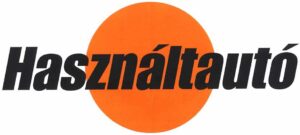
![]()
<hasznaltauto.hu>
The post TRADEMARK AND DOMAIN NAME INFRINGEMENT appeared first on Danubia.
